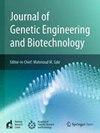Comprehensive system biology analysis of microRNA-101-3p regulatory network identifies crucial genes and pathways in hepatocellular carcinoma
IF 3.5
Q3 Biochemistry, Genetics and Molecular Biology
Journal of Genetic Engineering and Biotechnology
Pub Date : 2025-02-18
DOI:10.1016/j.jgeb.2025.100471
引用次数: 0
Abstract
Hepatocellular carcinoma (HCC) is a leading cause of cancer-related mortality worldwide. This study aimed to explore the role of hsa-miR-101-3p in HCC pathogenesis by identifying key genes and pathways. A comprehensive bioinformatics analysis revealed twelve hub genes (ETNK1, BICRA, IL1R1, KDM3A, ARID2, GSK3β, EZH2, NOTCH1, SMARCA4, FOS, CREB1, and CASP3) and highlighted their involvement in crucial oncogenic pathways, including PI3K/Akt, mTOR, MAPK, and TGF-β. Gene expression analysis showed significant overexpression of ETNK1, KDM3A, EZH2, SMARCA4, and CASP3 in HCC tissues, correlating with poorer survival outcomes. Drug screening identified therapeutic candidates, including Tazemetostat for EZH2 and lithium compounds for GSK3β, underscoring their potential for targeted treatment. These findings provide novel insights into the complexity of HCC pathogenesis, suggesting that the identified hub genes could serve as diagnostic or prognostic biomarkers and therapeutic targets. While bioinformatics-driven, this study offers a strong basis for future clinical validation to advance precision medicine in HCC.
microRNA-101-3p调控网络的综合系统生物学分析鉴定了肝细胞癌的关键基因和通路
肝细胞癌(HCC)是全球癌症相关死亡的主要原因。本研究旨在通过鉴定关键基因和途径,探讨hsa-miR-101-3p在HCC发病中的作用。综合生物信息学分析发现了12个枢纽基因(ETNK1、BICRA、IL1R1、KDM3A、ARID2、GSK3β、EZH2、NOTCH1、SMARCA4、FOS、CREB1和CASP3),并强调了它们参与关键的致癌途径,包括PI3K/Akt、mTOR、MAPK和TGF-β。基因表达分析显示,ETNK1、KDM3A、EZH2、SMARCA4和CASP3在HCC组织中显著过表达,与较差的生存结果相关。药物筛选确定了候选治疗药物,包括用于EZH2的他zemetostat和用于GSK3β的锂化合物,强调了它们的靶向治疗潜力。这些发现为HCC发病机制的复杂性提供了新的见解,表明鉴定的枢纽基因可以作为诊断或预后的生物标志物和治疗靶点。在生物信息学的驱动下,本研究为未来的临床验证提供了坚实的基础,以推进HCC的精准医学。
本文章由计算机程序翻译,如有差异,请以英文原文为准。
求助全文
约1分钟内获得全文
求助全文
来源期刊

Journal of Genetic Engineering and Biotechnology
Biochemistry, Genetics and Molecular Biology-Biotechnology
CiteScore
5.70
自引率
5.70%
发文量
159
审稿时长
16 weeks
期刊介绍:
Journal of genetic engineering and biotechnology is devoted to rapid publication of full-length research papers that leads to significant contribution in advancing knowledge in genetic engineering and biotechnology and provide novel perspectives in this research area. JGEB includes all major themes related to genetic engineering and recombinant DNA. The area of interest of JGEB includes but not restricted to: •Plant genetics •Animal genetics •Bacterial enzymes •Agricultural Biotechnology, •Biochemistry, •Biophysics, •Bioinformatics, •Environmental Biotechnology, •Industrial Biotechnology, •Microbial biotechnology, •Medical Biotechnology, •Bioenergy, Biosafety, •Biosecurity, •Bioethics, •GMOS, •Genomic, •Proteomic JGEB accepts
 求助内容:
求助内容: 应助结果提醒方式:
应助结果提醒方式:


